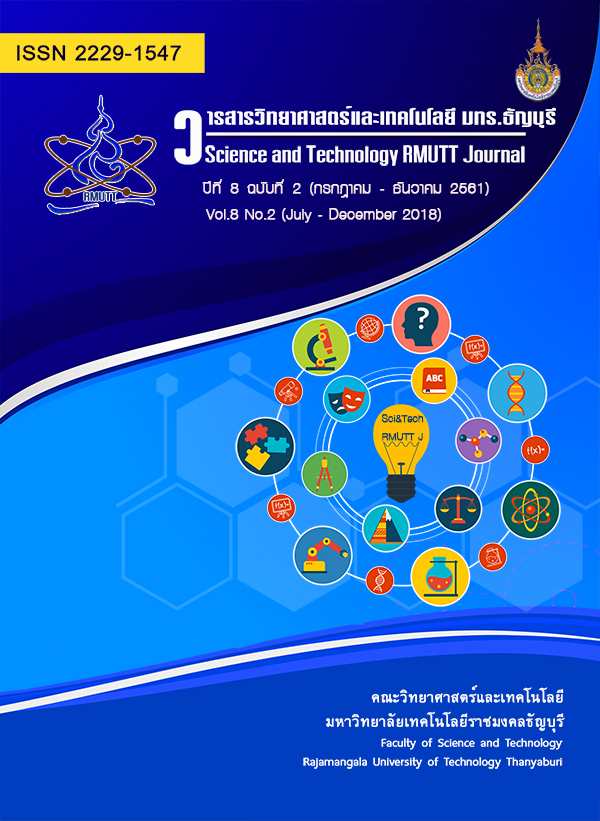functionalization of hydrogel for metals detection
Main Article Content
Abstract
Hydrogels are cross-linked hydrophilic polymers, and they have been functionalized with many substrates to make sensors. The advantages of hydrogel sensors over conventional sensors are that they have tree-dimensional structure, biocompatibility, large sensor loading capacity, easy to modifier and very low optical background. In this review, I overview three types of hydrogel sensors for selectively removing metal ions (i) Crown ethers-functionalized hydrogels, (ii) Protein or DNA-functionalized hydrogels, and (iii) Polymer-functionalized hydrogels.
Article Details
References
Zargoosh K. and Babadi F.F. Highly selective and sensitive optical sensor for determination of Pb2+and Hg2+ ions based on the covalent immobilization of dithizone on agarose membrane. Spectrochimica Acta Part A: Molecular and Biomolecular Spectroscopy. 2015. 137 : 105–110.
Gogoi N., Barooah M., Majumdar G. and Chowdhury D. Carbon Dots Rooted Agarose Hydrogel Hybrid Platform for Optical Detection and Separation of Heavy Metal Ions. ACS Appl. Mater. Interfaces 2015. 7 : 3058-3067.
Ahmed E.M. Hydrogel: Preparation, characterization, and applications: A review. Journal of Advanced Research. 2015. 6 : 105–121.
Hashemi P. and Zarjani R.A. A wide range pH optical sensor with mixture of Neutral Red and Thionin immobilized on an agarose film coated glass slide. Sensors and Actuators B. 2008. 135 : 112–115.
Chen Q., Zhu L., Zhao C. and Zheng J. Hydrogels for Removal of Heavy Metals from Aqueous Solution. Environ Anal Toxicol. 2012. S:2.
Zang Z., DoU Q., Gao H., Bai B., Zhang Y., Hu D., Yetisen K.A., Butt H., Yang X., Li C. and Dai Q. 30 s Response Time of K+ Ion-Selective Hydrogels Functionalized with 18-Crown-6 Ether Based on QCM. Adv. Healthcare Mater. 2017. 1700873.
Ju X.J., Zhang S.B., Zhou M.Y., Xie R., Yang L. and Chu L.Y. Novel heavy-metal adsorption material: ion-recognition P(NIPAM-co-BCAm) hydrogels for removal of lead(II) ions. Journal of HazardousMaterials. 2009. 167 : 114–118.
Mayes A.G., Blyth J., Millington R.B. and Lowe C.R. Metal Ion-Sensitive Holographic Sensors. Anal. Chem. 2002. 743649-3657.
Joseph K.A., Dave N. and Liu J. Electrostatically Directed Visual Fluorescence Response of DNA-Functionalized Monolithic Hydrogels for Highly Sensitive Hg2+ Detection. ACS Appl. Mater. Interfaces. 2011. 3 : 733-739.
Dave N., Chan M.Y., Huang P.J.J., Smith B.D. and Liu J. Regenerable DNA-Functionalized Hydrogels for Ultrasensitive, Instrument-Free Mercury (II) Detection and Removal in Water. J. AM. CHEM. SOC. 2010. 132 : 12668-12673 .
Helwa Y., Dave N., Froidevaux R., Samadi A. and Liu J. Aptamer-Functionalized Hydrogel Microparticles for Fast Visual Detection of Mercury(II) and Adenosine. ACS Appl. Mater. Interfaces. 2012. 4 : 2228-2233.
Masoumi M. and Ghaemy M. Adsorption of heavy metal ions and azo dyes by crosslinked nanochelating resins based onpoly(methylmethacrylate-co-maleic anhydride). eXPRESS Polymer Letters. 2014. 8(3) : 187-196.
Wang L.Y. and Wang M.Y. Removal of Heavy Metal Ions by Poly(vinyl alcohol) andCarboxymethyl Cellulose Composite Hydrogels Prepared by a Freeze-Thaw Method.ACS Sustainable Chem. Eng. 2016. 4 : 2830-2837.
Gao H., Sun Y., Sun J., Xu R. and Duan H. Mussel-Inspired Synthesis of Polydopamine-Functionalized Graphene Hydrogel as Reusable Adsorbents for Water Purification. ACS Appl. Mater. Interfaces 2013. 5 : 425-432.


